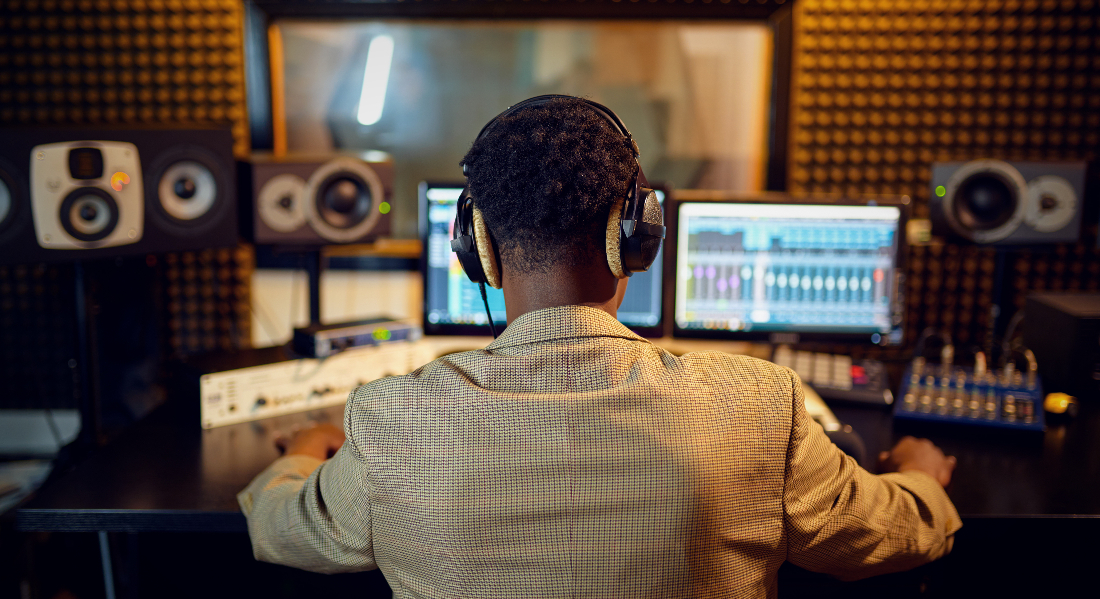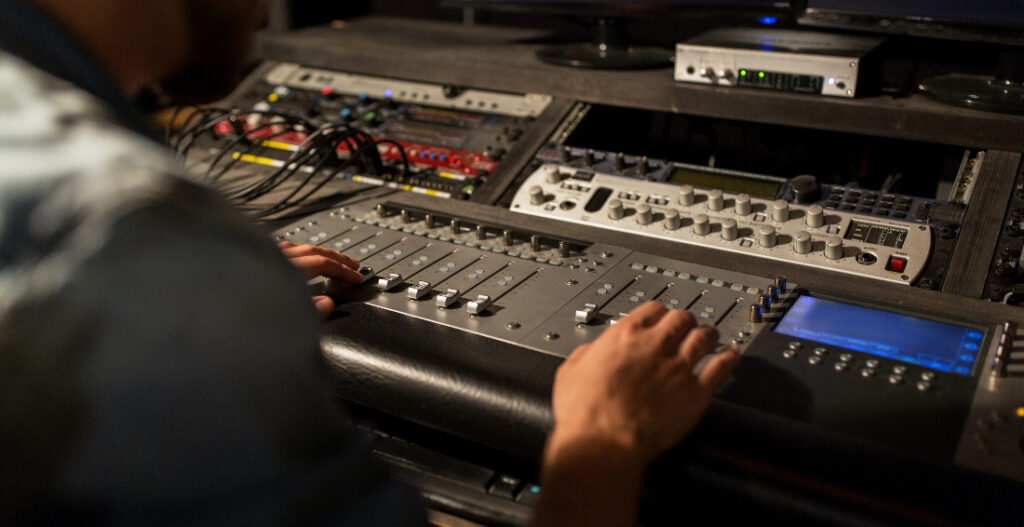What Is Mixing In Music Production?
When music, or any sound really, started being recorded, there was one track. Whether it was one person or one hundred, everybody got together and played their part and they had to get it in one take. Ah, the joys of one-track recording–and wasted recording materials if somebody made a mistake.
As music recording technology advanced, audio engineers and record producers began working with multiple tracks and digital recording became the norm. No more wasted tape or vinyl! Today, digital audio workstations and other software and equipment means the possibility of working with 100s of tracks. And nobody has to be in the same room with anybody.
That’s where mixing in music production comes into play. The ability to bring all of those tracks together into one cohesive unit makes a song better than its parts. The ability to use so many tracks in a single song has been an incredible boon to the music industry as a whole, but doesn’t necessarily make it any easier to create a hit.
It’s the mixing engineer’s job to ensure all of those tracks work together. Think of it like making a cake (and not just because of the word “mixing”). You start out with all of these ingredients, but if they aren’t put together in the right amounts, baked at the right temperature, and left in the oven the right amount of time, your tasty treat will turn into a huge burnt mess.
The tools of the trade for a mixer is the audio mixer, a console where they can control equalization (EQ), compression, panning, reverb and delay, and other levels of the tracks they are given. By folding the different song sounds together, reducing any clashes, and emphasizing certain elements, a fully realized and professional record is created.
What is Mixing in Music Production?
In those early days, adjustments needed to be made before the song was recorded for desired effects. Whether it was how an instrument was positioned, the audio levels of a microphone, and even where the artists themselves were placed in a room. Now all of those adjustments can happen on the fly or after recording is complete.
The most prominent piece of gear needed for mixing in music production is the mixing console. Also known as a mixing board, software mixer, or mixing desk, the console is equipped with multiple inputs for multitrack recorders. They take the different signals (vocals, instruments, MIDI files) and allow the engineer to manipulate those sounds.
Even if you’ve never been in a recording studio, you are probably familiar with a mixing board: table or desk with a series of knobs, sliders, and buttons. These dials all serve a specific purpose, from handling specific signal inputs to manipulating those signals with a series of effects.
Mixing isn’t only used in the recording industry. Sound is incredibly important on film sets, TV studios, and other forms of media. Mixing background noises, dialogue, the sound, and music during transitions takes an incredible amount of talent and an ear to match.
The difference between mixing in music production and mastering
Where mixing is the process of combining all of the individual tracks into a single song, a mastering engineer takes that finished song and gets it ready for release. They are responsible for the final quality control of a song, how it fits with the rest of the album, and ensure it sounds great on every conceivable speaker, system, or device.
In addition to cleaning up any cracks, pops, or other imperfections missed during the mixing stage, the mastering production process also includes the technical aspects of encoding a song with metadata. This information (ISRC, UPN, song title, and other information) needs to be readable on any and all digital representations (CDs, MP3, and so on).
This is important for song aggregators such as Pandora, Spotify, and other streaming services. Specific services may require specific resolution of a song, which will differ from a CD, which differs from traditional broadcast play on the radio. Mixing and mastering work together to make the music you listen to in your car, on your phone, or your home entertainment system sound good.
The Process of Mixing in Music Production
 EQ (equalization) is the process of giving the different instruments in your song the right frequencies. Think of a color palette: Once you’ve mixed three basic colors together in equal amounts, you end up with black. The same thing can happen if each instrument is given the same amount of weight.
EQ (equalization) is the process of giving the different instruments in your song the right frequencies. Think of a color palette: Once you’ve mixed three basic colors together in equal amounts, you end up with black. The same thing can happen if each instrument is given the same amount of weight.
Every instrument brings its own “color” to a song, and a good sound engineer knows how to put those colors together in the right amounts. Instead of a muffled sound, mixing during audio production ensures your instruments are all used to their fullest potential without taking away from (or barging all over) one another.
When listening to a song in stereo, you’ll often hear certain instruments or sounds at different volume levels or are coming from different “directions.” When panning is used in audio mixing, you can control how the brain receives these signals. When a sound originates in your left ear and seems to move to the right ear, that’s panning.
In a live music situation, your ears can pick up where an instrument is coming from almost immediately because the instruments are located on one side of the stage or the other. That’s done by design on stage and can be recreated when panning is used during the mixing phase of a song.
Although guitarists can do incredible things with the tools of their trade, other instruments need a little more help. Effects are used after the instruments–even guitars–have been recorded and enter the mixing stage. This is when reverbs, compression, and other effects are added to the signals.
Again, instruments each provide their own special sauce to a song, but in some cases need a little boost to complete the entire picture. That’s what the mixing process is for, giving the audio engineer the tools (plug-ins, processors, and more) to breathe new life into otherwise dull or lifeless tracks.
While many of these processes are done manually, automation allows engineers to be more efficient with their time. If there’s a certain sound that is heard throughout an album, automation presets are employed to create those sounds during each song (when it’s needed).
Learn Mixing in Music Production from Industry Insiders
We’ll be honest: There’s only so much you can learn about mixing in music production from a blog post. The best way to learn mixing, audio engineering, or music production–or almost any other creative endeavor–is to jump in and get your hands dirty. Even then it’s hard to know if you’re learning the correct processes.
As digital audio workstations become more and more accessible, the number of YouTube videos, message boards dedicated to audio engineering, and online tutorials has grown exponentially. But how do you know who to believe? And there’s no way to ask a video a question or get feedback from a .pdf.
The only way to really get the “inside dope” on mixing in music production is to go to those making a living doing it. And that’s precisely what Recording Connection offers our students. We put you inside a real-world recording studio so you can learn the ins and outs of mixing tracks, how (and why) to use a high pass filter, and understand the dynamic range of different signals.
Our Audio Engineering and Music Production Program will put you side-by-side with a mentor, a professional working in the industry right now. You’ll get answers to your questions, focus on your strengths, and help with your weaknesses. Our mentors have worked with the biggest names in the industry–and now you’ll work with them in their studio.
With more than 300 locations around the U.S., you won’t have to uproot your life to get this education either. Why move across the country to attend a “name” university, and sit in a classroom for four years if you don’t have to? Our programs last six to nine months and offer job placement assistance for up to a year upon completion.
You can probably learn the basics of a digital audio workstation on your own, but if you’re interested in a career, you’ll need much more than that. And Recording Connection can give that to you if you have the drive, determination, and desire to make it happen. It’s time to amplify your life–Apply Today.





